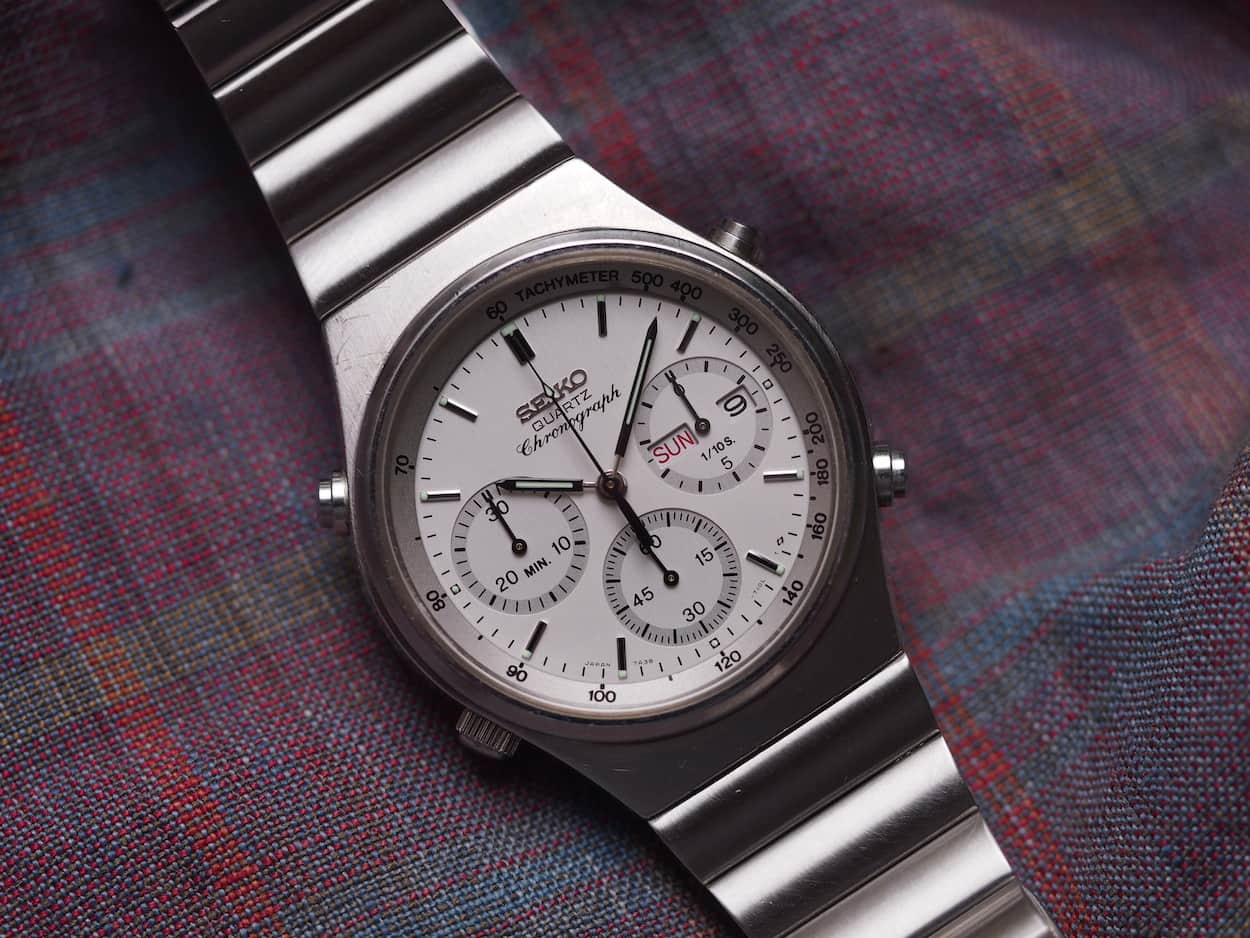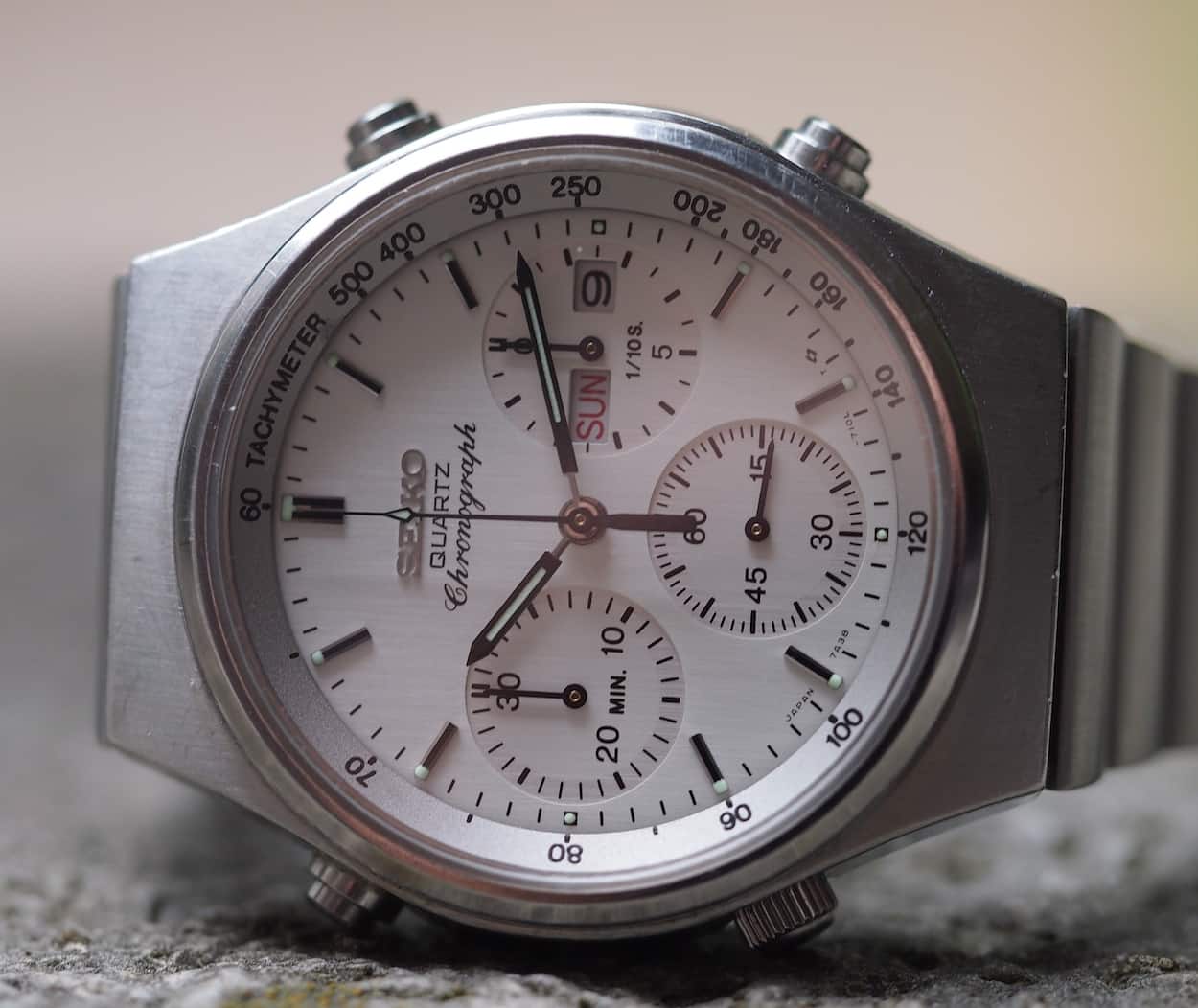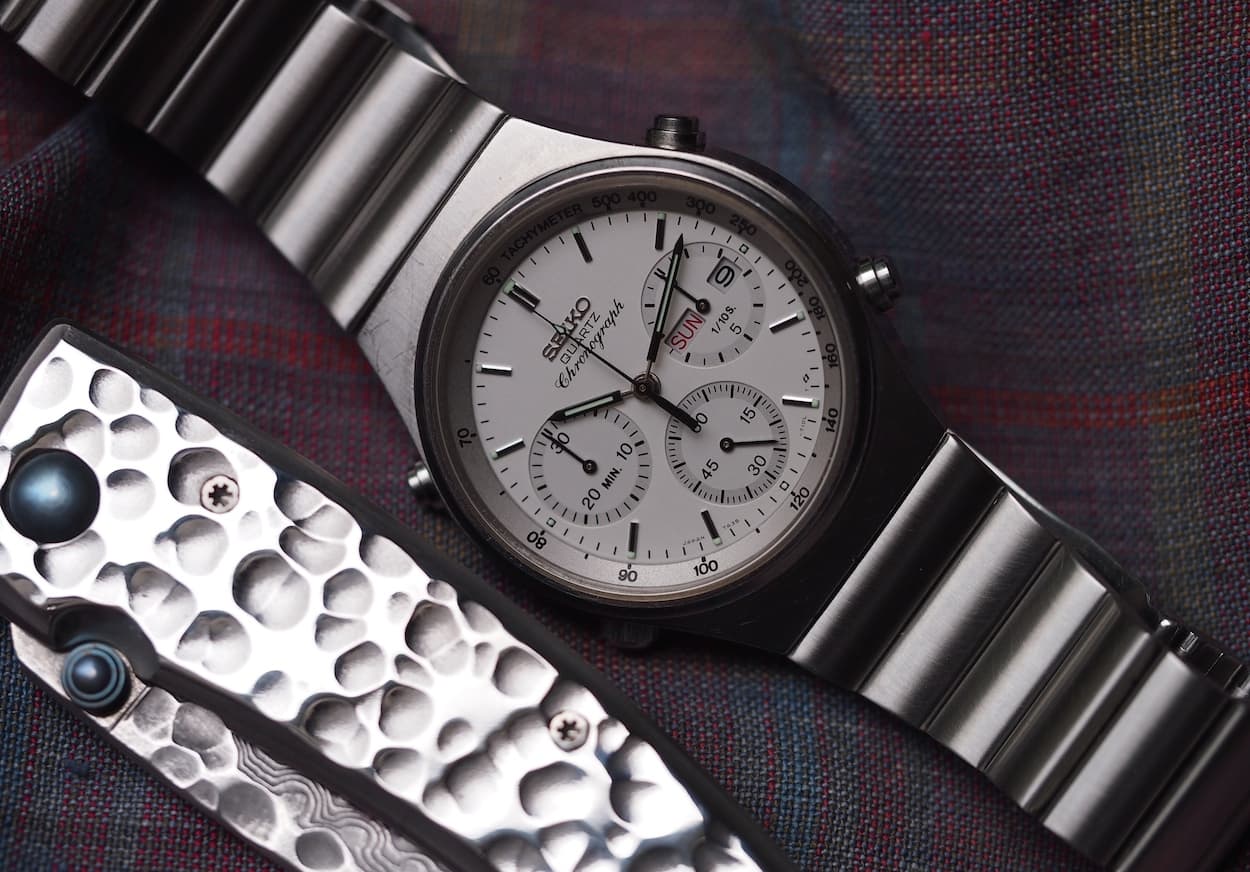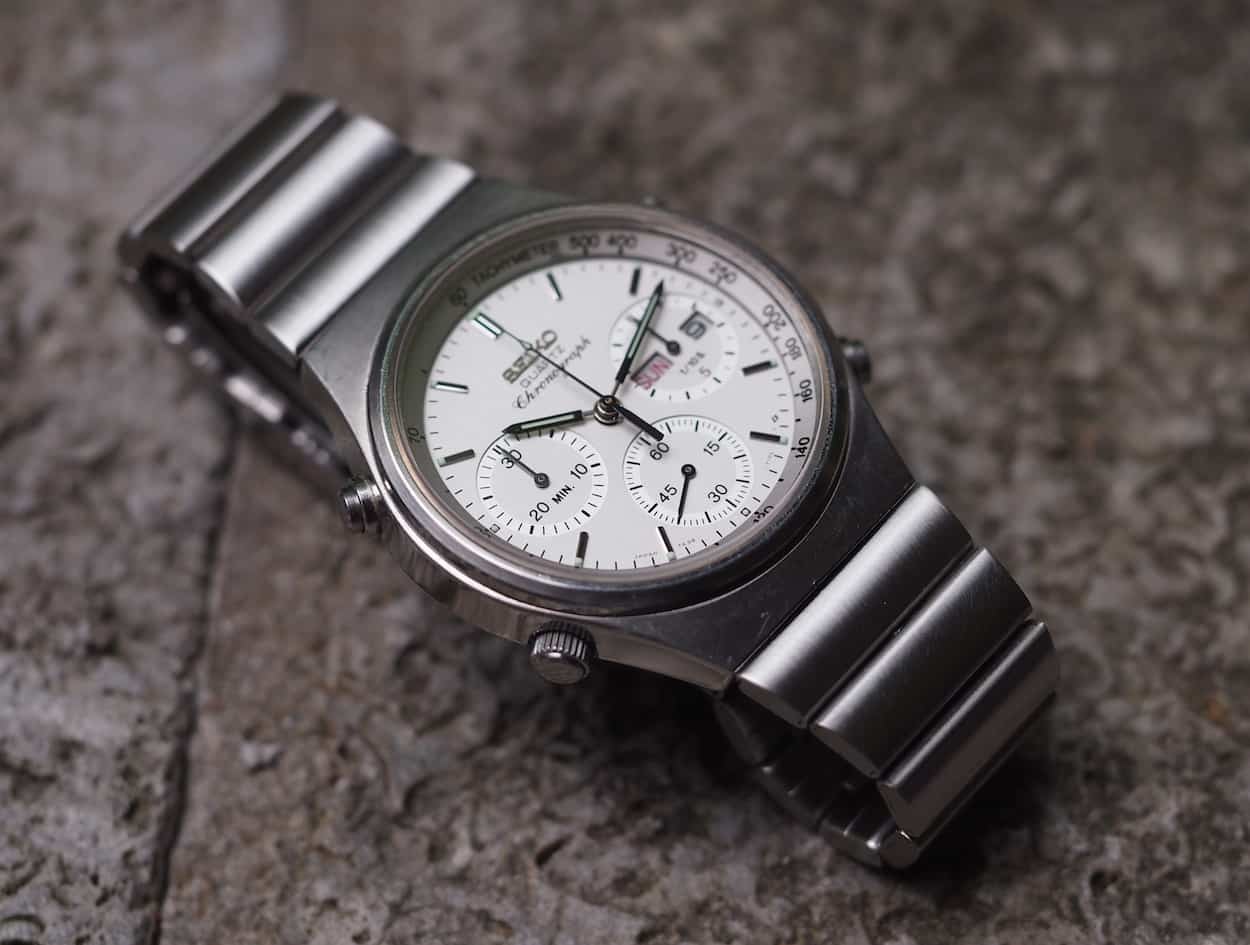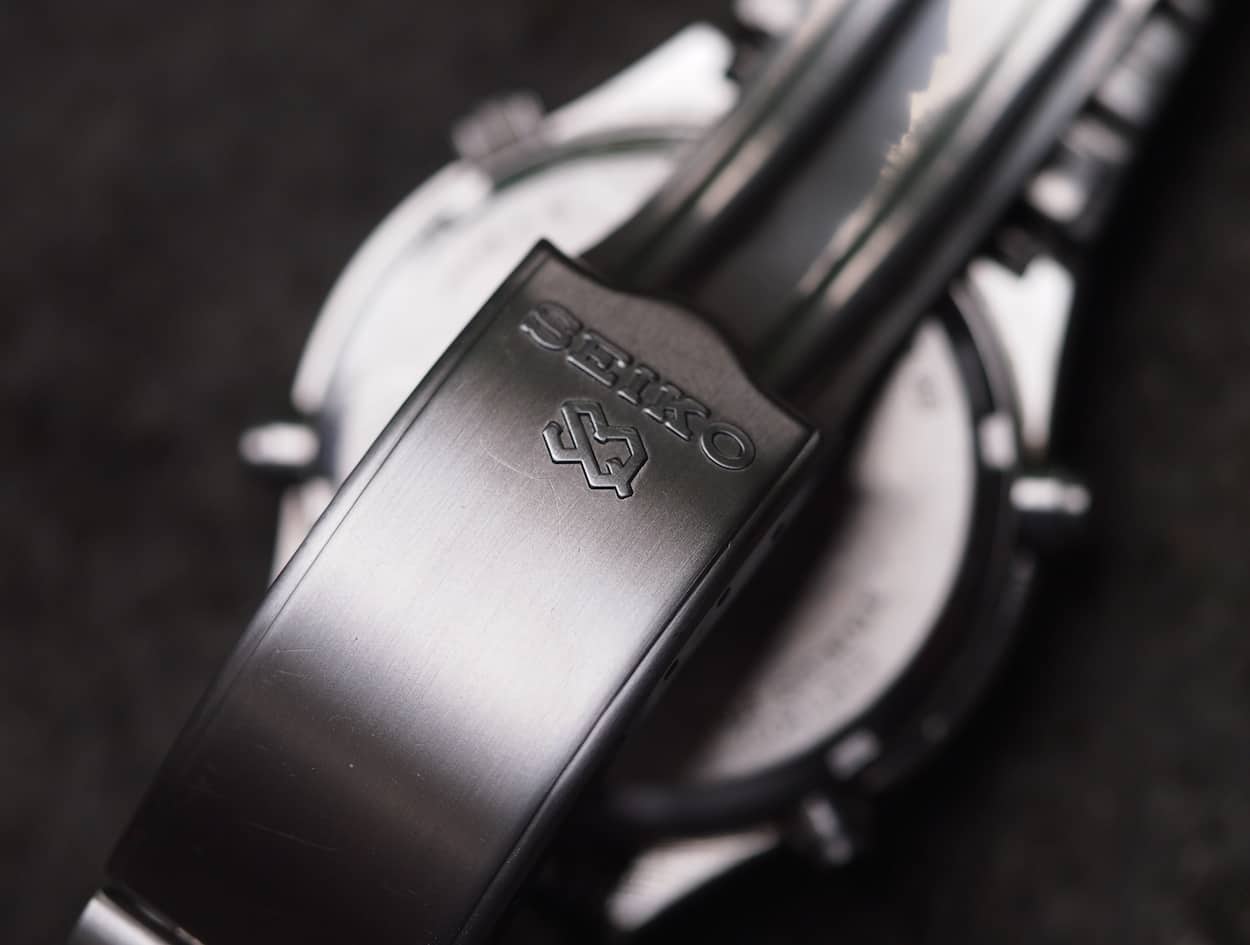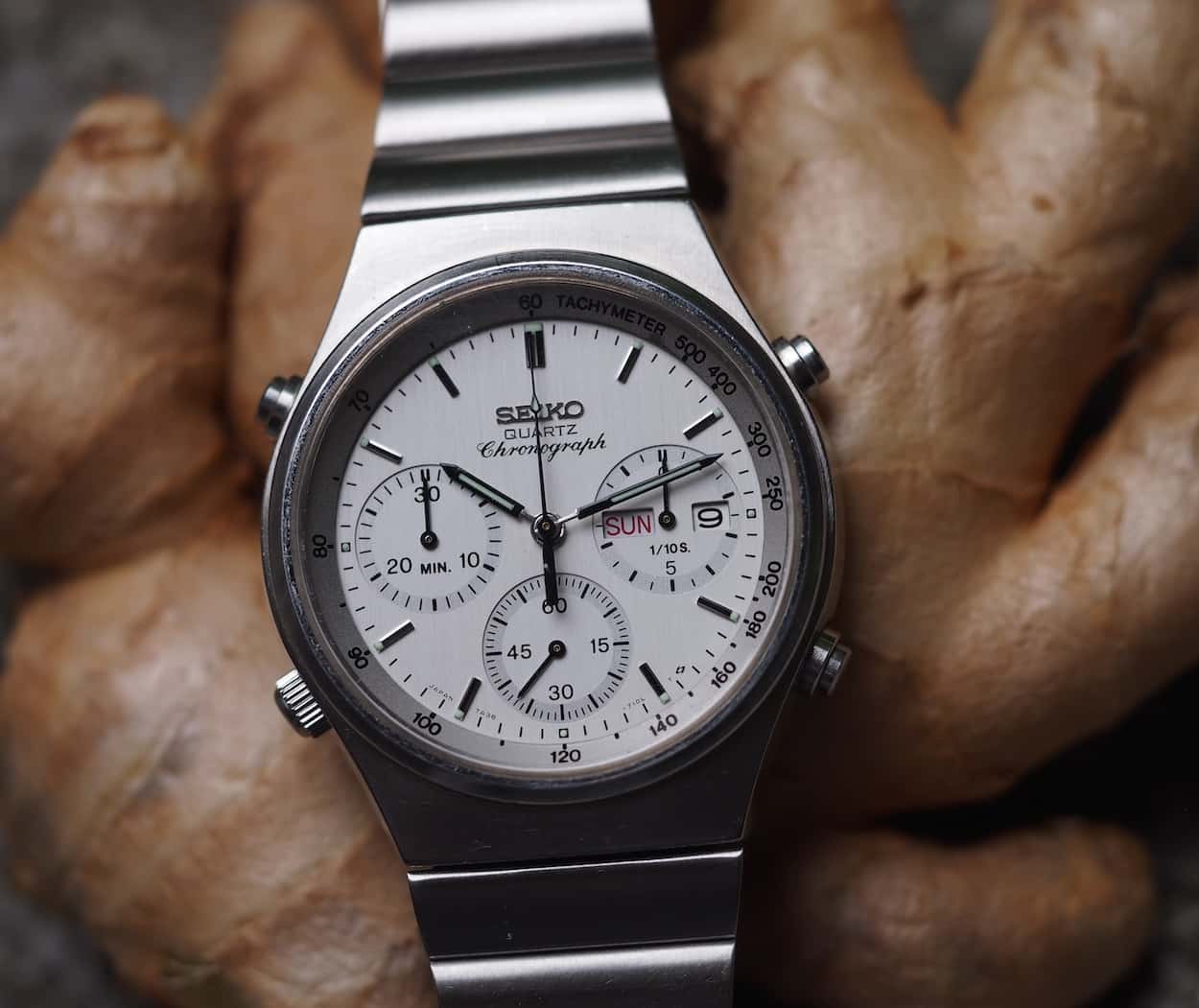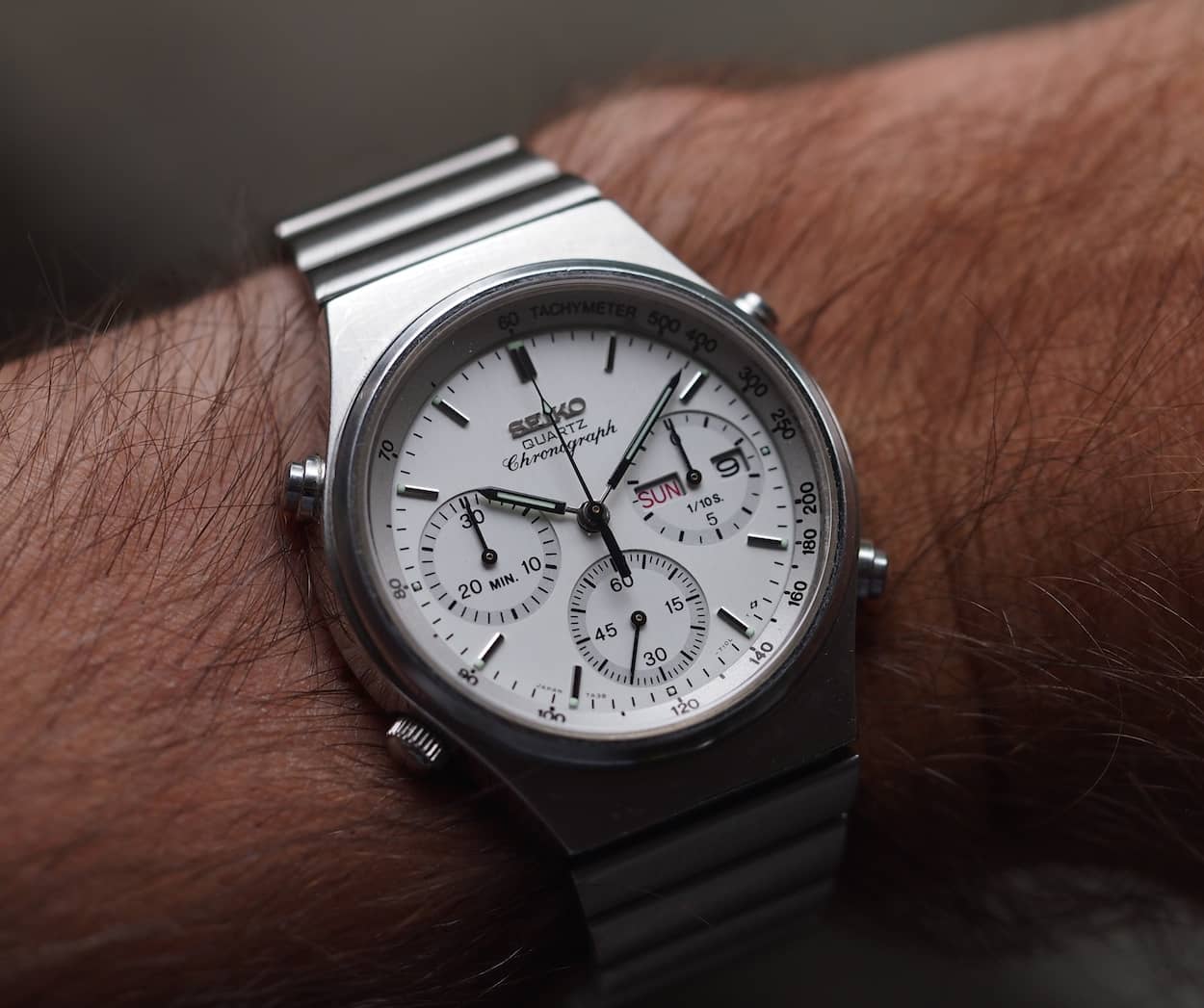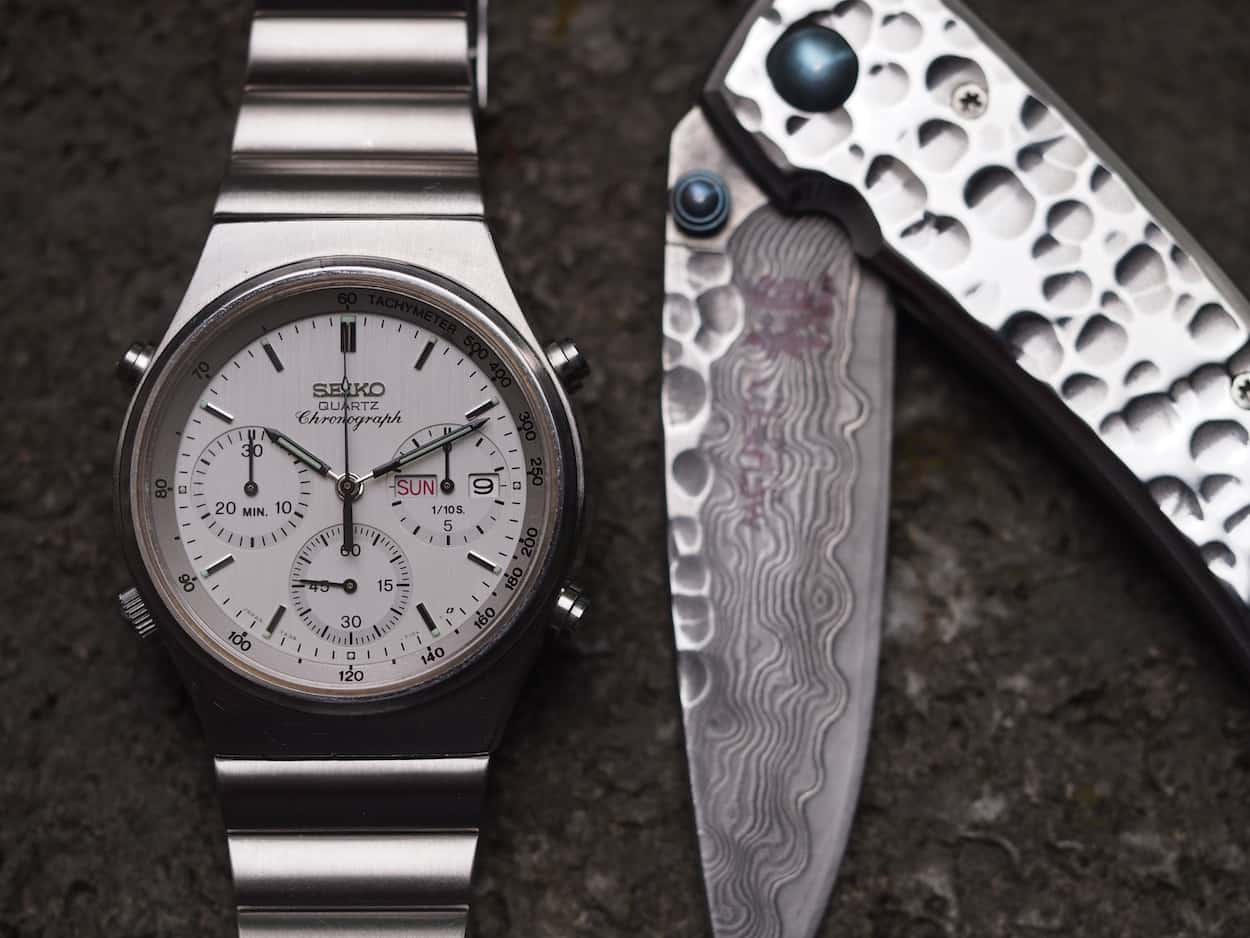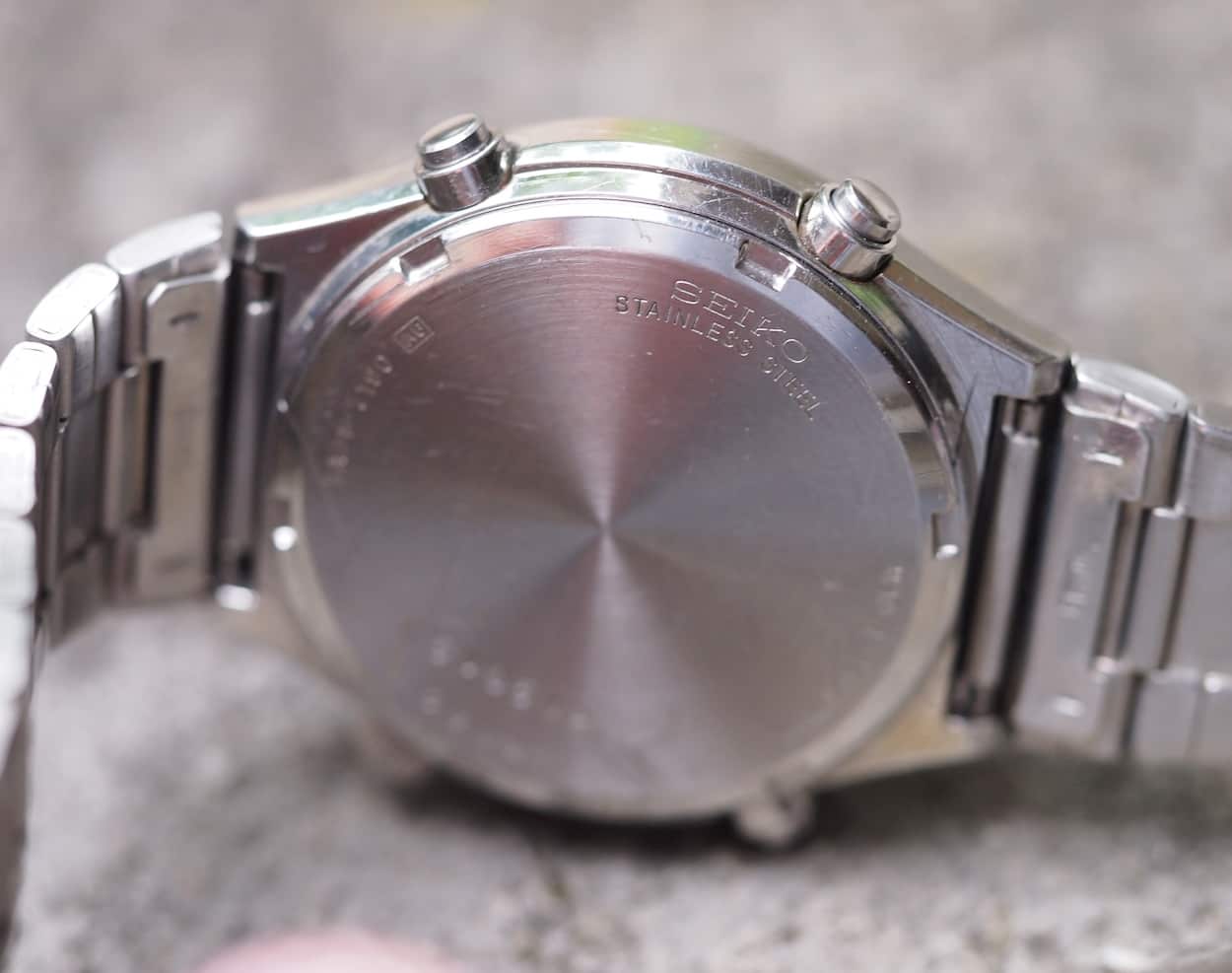#TBT Seiko 7A38 Chronograph
I mentioned several weeks ago that #TBT would begin exploring some “different” areas. Hopefully, with recent discussions on pieces such as the King Seiko and Rolex Oysterdate Precision, we’ve taken solid steps towards fulfilling that message. Today’s subject will continue to push the boundaries for this series. Yes, this week’s #TBT will likely prove controversial because the selected watch contains something unique: a battery. Despite my general aversion to anything quartz, I actually find today’s piece very attractive and interesting. Plus, it combines two of my favorite horological subjects: chronographs and Seiko’s. Grab your parachute pants and journey with me back to the era of arcade games and synthesizers to take a look at the Seiko 7A38 chronograph.
The Seiko 7A38 is simply a great looking watch and is from the series of the first Quartz analog chronographsThe Seiko 7A38…a brief history
Ah, the 1980’s… This was the heart of my childhood and I look back upon these times fondly. The music, the celebrities, the products, etc. all suggested an entrance into the very modernity that we see today. Of course, when looking back at the hairstyles and clothing, many of these things were so exaggerated that they seem laughable today. Electronics such as the Walkman, Apple and IBM computers and stereo systems were all the rage, so it shouldn’t surprise anyone that quartz watches truly began to hit their stride. Sure, the 1970’s saw an absolute pummeling of mechanical watches by quartz on the premium side, but by the 1980’s quartz was mainstream and featured by both expensive and dime store brands. Both digital and analog watches were available in quartz form but, strangely, when it came to chronographs, the only quartz option was in the form of digital. Interestingly, it took until 1983 for Seiko to introduce the world’s first analog chronograph under the model name of 7A28.
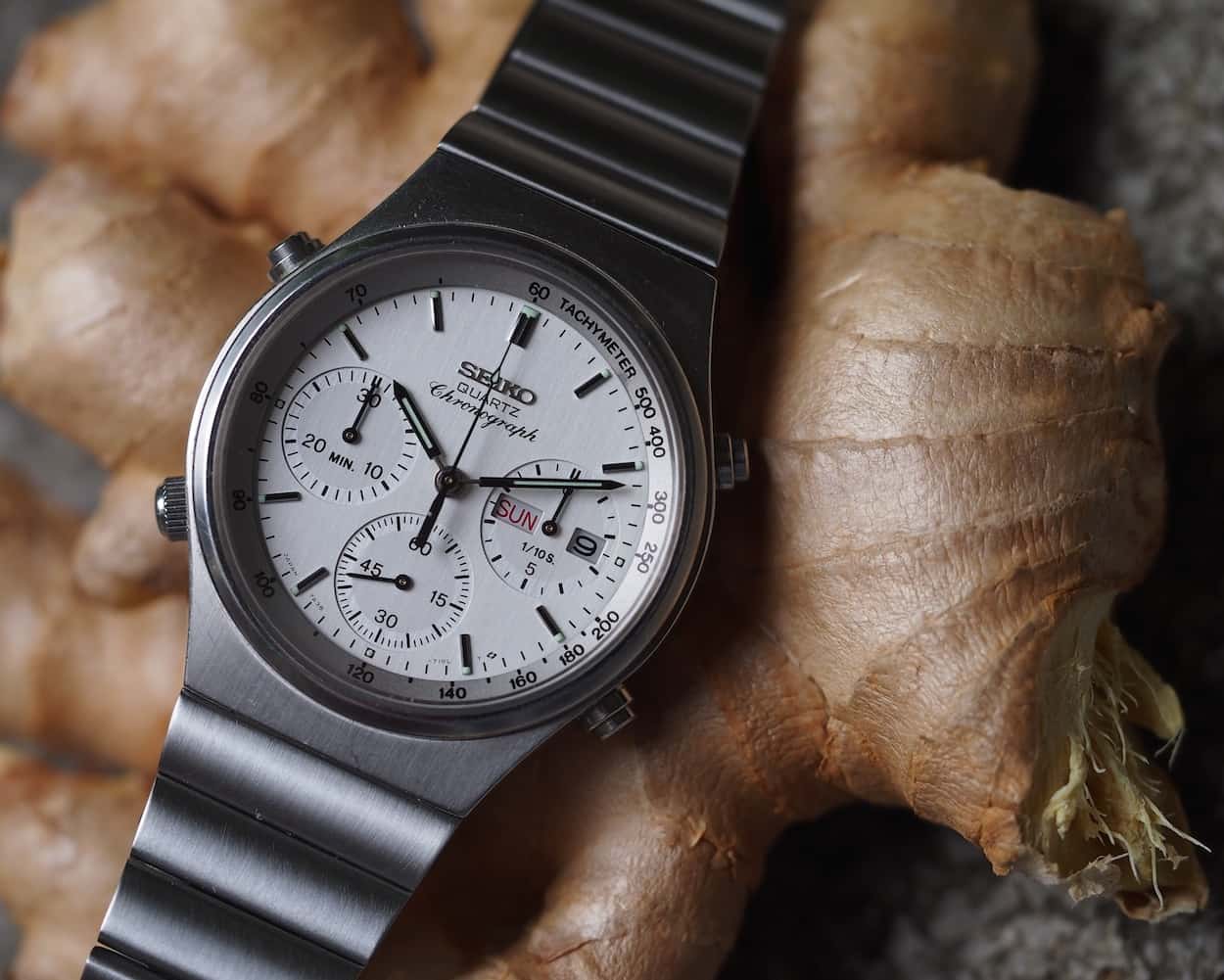
A fine vertical, brushed surface is found on the dial of the Seiko 7A38 and echoed on the case and bracelet.
The Inner Workings…the 7A28 and its Seiko 7A38 offspring
Seiko’s 7A28 was introduced with a 15 jewel, adjustable, quartz movement that lacked any plastic parts within the gear train. It featured 1/20-second timing (amazing to watch) and could measure up to 30 minutes. 30 minutes doesn’t sound like much, but innovation usually starts small. The 7A28 was in some well-known films such as the James Bond movie “A View to a Kill” and a special series of Giorgetto Giugiaro designed pieces were famously worn in “Aliens”. The brand wasn’t done innovating, though, and decided to add an inconspicuous day and date function to the 7A28: thus, in 1984, the Seiko 7A38 was born.
The Seiko 7A38 differs only from its 7A28 stable mate by addition of the day and date function. Internally, the movement stayed with a total of 15 jewels. There were many variations of the 7A38 in case design, bracelet or strap, material finish and dial color, but all held the same functionality and are made of stainless steel. Most cases were roughly 36mm and in this case, the -7190 model, contained 20mm lugs. The crystals were flat mineral glass. Thickness was slim at 11mm and water resistance was a practical 30M. Interestingly, the movement could, and can, be serviced and adjusted much like any mechanical movement due to its construction. It’s an interesting detail that differs little from, say, the Rolex Oysterquartz in its serviceability and speaks to the effort that Seiko put into the design.
I had been casually looking for either a Seiko 7A38 or 7A28 when I stumbled upon today’s piece while cruising eBay. It was roughly a year ago and I caught the listing about 5-10 minutes after it had gone live. The piece, built in 1985, had just been serviced, had new gaskets, battery and the owner had performed a popular modification by upgrading the crystal to sapphire. Furthermore, he included all of the old parts in the sale and priced it at a little below $200; I hit the button.
Impressions of a Seiko 7A38
I received my Seiko 7A38 a week or so later and I was instantly amazed by the quality of detail on the watch. I hate to start with the bracelet, but this jumped out at me right away. From a looks perspective, there’s something that almost reminds me of the similar era Ebels that were unbelievably popular. Sure, the quality isn’t the same as an Ebel, but the quality is fantastic compared to most bracelets on Seiko’s today, which must have made it astonishing 30 years ago. The bracelet is smooth, doesn’t pull hair, and has perfectly uniform matte finishing.
The links aren’t loose and it connects to a simple, but solid, stamped clasp adorned with the famous “SQ” meaning “Seiko Quartz”. I only needed to adjust the clasp to secure a decent fit, but links with “slide-out” pieces would make for an easy adjustment.
Ok, so the bracelet of the Seiko 7A38 hit me first, but the dial deserves equal billing. The piece has a great layout and uses timeless, purposeful font. If I had to take issue with anything on the dial, it would be the cursive script of “chronograph”, but that would be a minor issue. All flows well and the font, in general, wouldn’t look of place on something Swiss. The hands on the 7A38 are also well fashioned and of a very traditional style. Looking at other details, such as the applied indices and small outer lume plots, one gets the feeling that Seiko wanted to issue a watch that was very much in keeping with the style of famous chronographs such as the Omega Speedmaster in order to show how quartz could compete. I think it’s this fact that makes it so endearing in lieu of what must have been a tempting option to create pieces that were shocking in nature. I mentioned the smooth integration of the day and date window on this watch and, here again, I really wonder why watch companies seem to so rarely get this right today. Here’s a perfect example of a watch that gives you the right information without spoiling the overall look.
The Seiko 7A38 isn’t a big watch at 36mm but it wears nicely. It does feel a little small compared to some of my mechanical chronographs and, perhaps, looks more at home at a nice dining event or business meeting versus a vintage car race, but it is elegantly sporty. I think that the bracelet dresses it up and I think, despite the hidden lugs, that it would look good with a black leather-racing strap. Besides, there are other 7A38’s with outer bezels that may fit a larger wrist more aptly. It’s very comfortable, though, and I think it looks far more expensive than its price would suggest.
Using the Seiko 7A38 is a treat. Time setting is managed by pulling out the lower left crown. The first click allows for day and date setting by turning the crown forwards or backwards. The second click hacks the movement and time can be changed. The upper left button allows for split timing while the right side buttons act as normal stop-start and rest buttons. The cool factor kicks in when the chronograph is engaged as the hand in the right register flies around the sub dial, frantically, in one second. When the chronograph is stopped, this register measures 1/20-second increments. Yes, I get the fact that a mechanical 1/20 second complication is something truly special, but this is an amazingly cheap thrill that never gets old.
Spend it wisely…finding a Seiko 7A38
Finding a Seiko 7A38 is relatively easy. Finding the exact model you want once you become more familiar with all the variations can present some difficulty, though. A lot of the pieces have been heavily worn and are often damaged or in need of repair. Furthermore, they are immensely popular amongst Seiko collectors. As far as desirability, I’d say that value increases with the sportiness of the execution. Pieces with rotating bezels tend to be most valued followed by the simple pieces with tachymeter scales. The two-tone varieties and dressier models are generally more reasonable. Pricing seems to be all over the map with 7A38’s and decent pieces can be found for under $200 while some “dreamers” may list rare country-specific models for over $800. In my opinion, if you find a really nice piece for $300 or below, that feels about right. Beware, though, of buying pieces that are no longer fully functional for anything more than $100 as a service will likely run you well over $100. eBay is a great place to look for these and can help to familiarize you with all the different varieties. Time will tell how the market treats the early Seiko analog quartz chronographs in terms of value, but as of now, good ones priced fairly sell without issue.
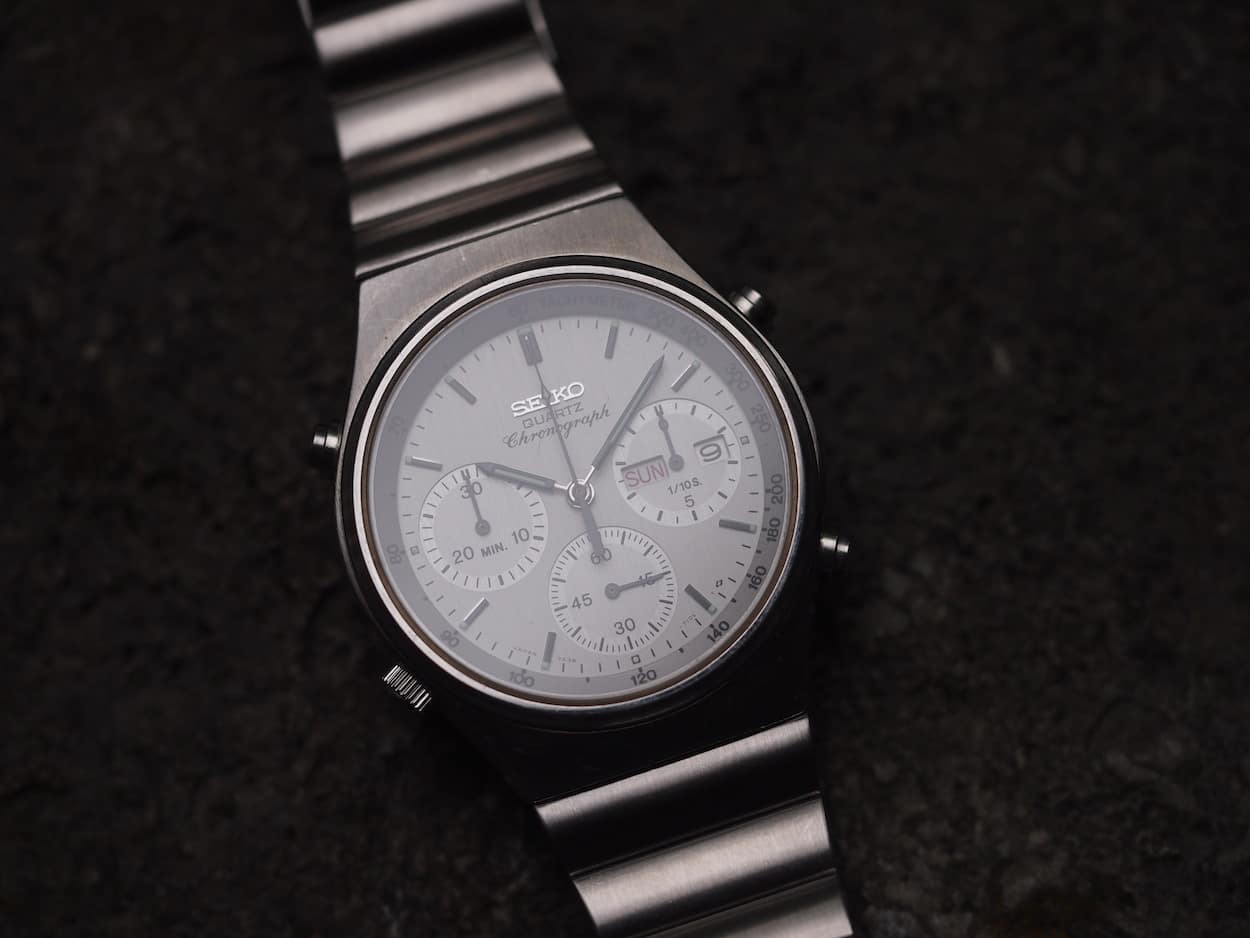
A popular modification by owners, this Seiko 7A38 features a sapphire crystal in place of the stock mineral glass
I enjoy my Seiko 7A38 tremendously. It’s a well-made watch that has stood the test of time in terms of design and it has firmly etched its place in watch history by being part of the first series of analog quartz chronographs. I think the 7A38, even the 7A28 for that matter, makes a great purchase candidate for any vintage chronograph collector who focuses on groundbreaking pieces such as the first automatic chronographs, etc. And, compared to almost any mechanical chronograph, these are tremendously affordable. Feel free to share your thoughts about the Seiko 7A-series below; let’s see some variety! As always, thanks for reading and we’ll be back next week!

